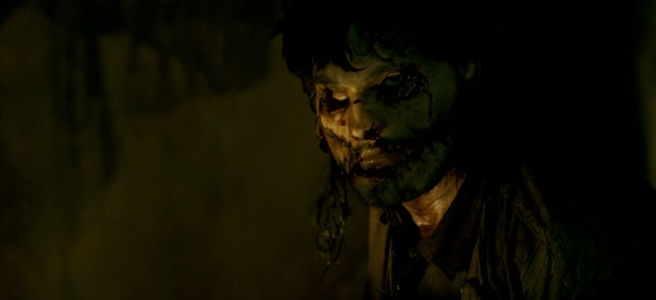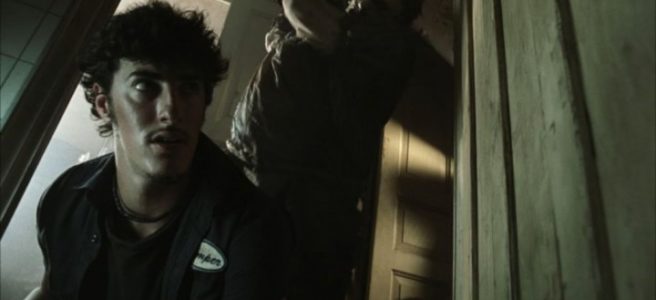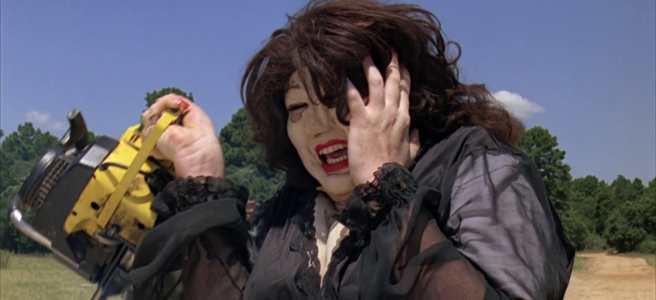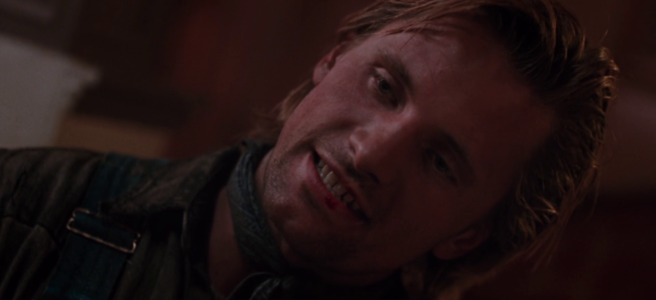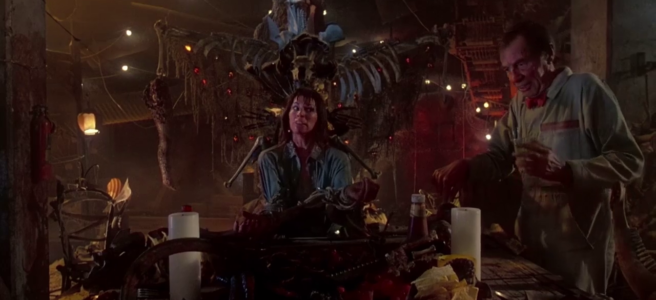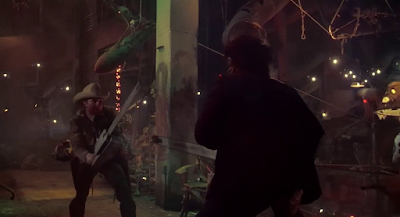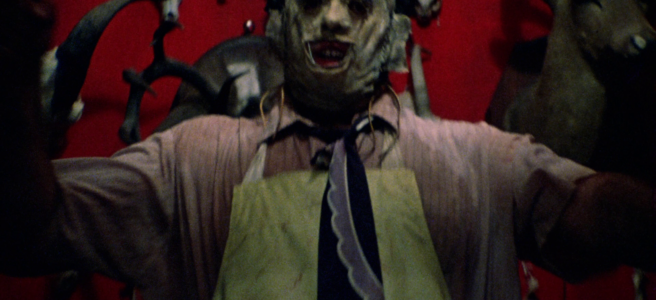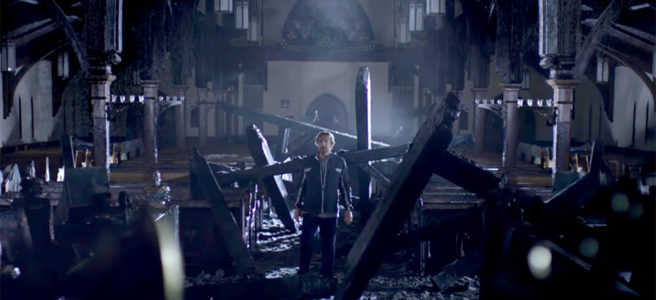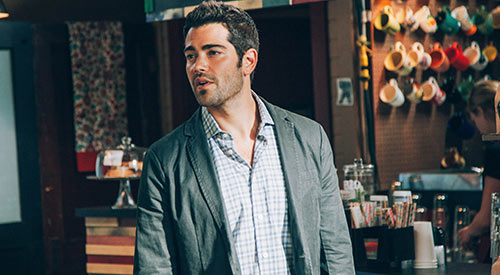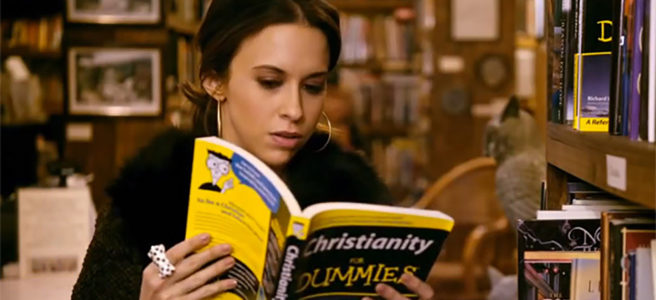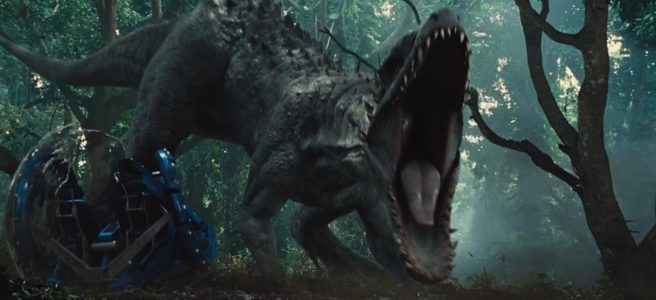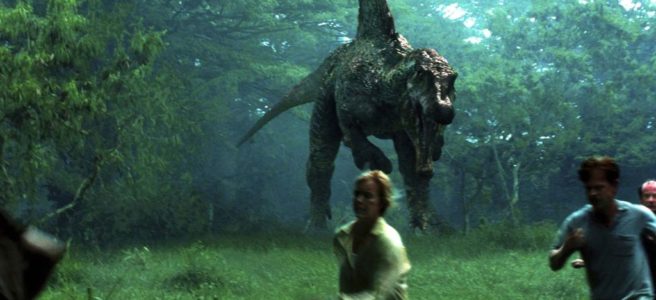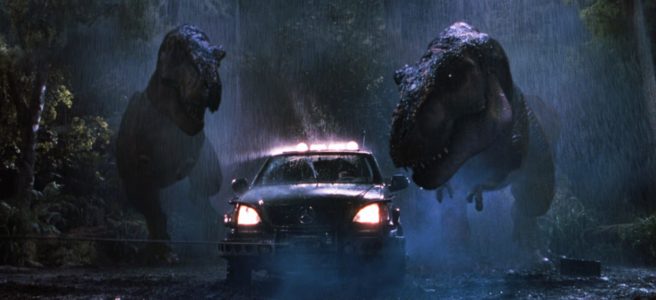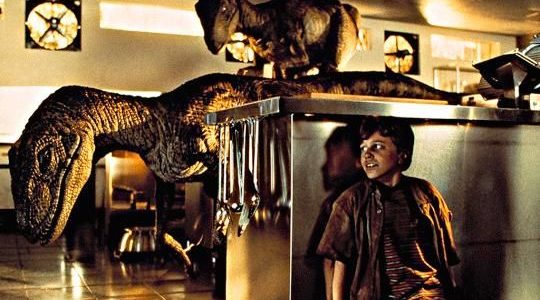Welcome back to The Texas Chainsaw Massacre retrospective! In today’s entry we’re going to be looking at the sixth entry in the franchise, the 2006 prequel-to-the-remake, The Texas Chainsaw Massacre: The Beginning. After the considerable financial success of the remake, a follow-up seemed inevitable. However, was a prequel the right way to go to fill in some of the blanks left by its predecessor? Read on to find out…
PRODUCTION
After the considerable success of The Texas Chainsaw Massacre, Platinum Dunes started looking towards other horror franchises to remake for low cost and high turn-around. Their next project was The Amityville Horror, but when that failed to scare up higher numbers despite having more than double the budget, they turned their eyes back to the Chainsaw franchise. However, Dimension Films were looking to steal the franchise from underneath New Line after putting in an offer with the rightsholders. To prevent this, New Line ended up having to pay an additional $3.1 million just to retain the rights, increasing the film’s budget considerably. Jonathan Liebesman (who would later go on to direct such stinkers as Battle: Los Angeles, Wrath of the Titans and Teenage Mutant Ninja Turtles) was hired to direct, having just come off of success with Darkness Falls and Rings (a short prelude to The Ring Two). Liebesman had been considered to direct the previous film, but had made Darkness Falls instead.
Interestingly enough, the landscape of horror had shifted in the three years between Chainsaw films. The torture porn genre had begun kicking off with such films as Saw, Hostel and Wolf Creek taking over the market and emphasizing brutal violence and gore. In the making-of featurette for the film, the producers name-drop Hostel and The Hills Have Eyes, claiming that Chainsaw was the granddaddy of extreme horror and therefore they had to push the envelope as far as possible to beat the other films of the time. Scott Kosar was supposed to return to write the script, but was unavailable at the time. David J. Schow, who had written the screenplay for Leatherface: The Texas Chainsaw Massacre III, returned to co-write the story along with screenwriter Sheldon Turner.
Possibly the best part about making the next film in the franchise into a prequel was that R. Lee Ermey could return as Sheriff Hoyt, despite having been killed off in the last movie. Andrew Bryniarski was also able to return as Leatherface. The new cast included more pretty, young up-and-comers, most notably Jordana Brewster (Mia from The Fast & The Furious) as Chrissie and Diora Baird (known for Wedding Crashers and risque modelling for Guess? and Playboy) as Bailey. The leading roles were rounded out by Matt Bomer (Ken from the Magic Mike series) as Eric and Taylor Handley as Dean.
PLOT SYNOPSIS
The film opens with a woman at the old slaughterhouse being forced to work by her supervisor even when her water breaks. The birth presumably kills her and the deformed baby is thrown into the dumpster out behind the slaughterhouse as if this were an Amazon warehouse. However, the baby is found by Luda Mae Hewitt and brought home to be adopted as a son named Thomas. The boy grows up being made fun of for his skin disease and he ends up making a mask from a dead coyote to hide his face, eventually going on to work at the slaughterhouse under the very supervisor who had unknowingly thrown him away years ago. However, the slaughterhouse is eventually shut down for health violations, which devastates the town. When the supervisor tries to tell Thomas to stop working, he turns on him and kills him, stealing a chainsaw in the process. The local sheriff discovers this and goes to Charlie Hewitt to try to apprehend Thomas, but when they find him, Charlie kills the sheriff and assumes his identity, becoming Sheriff Hoyt. He takes the sheriff’s body home and cooks him, declaring that they’re not going to leave this town and let it be overrun by pillagers.
Meanwhile, brothers Eric and Dean, along with their girlfriends Chrissie and Bailey, respectively, are heading through Texas after being drafted to fight in the Vietnam War. Eric has already been on one tour of duty and is gung-ho to fight alongside his brother, but Dean is planning on draft dodging into Mexico during the trip. When they stop at a local shop, Chrissie and Bailey are accosted by a group of bikers and decide to continue on their way. However, one of the bikers chases their car and tries to rob the group. This distracts Eric and causes him to get into an accident with a stray cow, flipping the vehicle and ejecting Chrissie from it in the process. The female biker sticks up the injured youths still in the vehicle, but then Hoyt arrives and blows her away with his shotgun. Hoyt finds burnt draft papers and realizes that one of the men was planning on draft dodging, but Eric lies and says that it was him in order to protect his brother. Hoyt forces Eric, Dean and Bailey into his police car and then takes them back to his house. Chrissie comes to and watches as he takes them away. Moments later, a tow truck arrives to take away their vehicle and Chrissie hides inside the wreck, which also gets taken to the Hewitt residence. She then sneaks away to try to find help.
Once they have arrived, Bailey is tied up under the table inside the house and Dean and Eric are tied up in the shed, where Hoyt tortures them until Dean admits that he was the one who was planning on skipping the draft. Hoyt tells Dean that he’ll let him go free if he can do ten push-ups, which Dean succeeds at despite being beaten mercilessly by Hoyt. Eric then manages to break free and rescues Bailey, then tries to sacrifice himself as a distraction while Dean and Bailey flee. However, Thomas captures Bailey with a meathook and drags her back and Dean steps in a bear trap before Hoyt knocks Eric out. Meanwhile, Chrissie comes across the boyfriend of the biker who was killed, who takes her back to the house in order to rescue his girlfriend.
That night, Thomas takes Eric to the basement and begins skinning him alive, while Bailey is taken upstairs and raped by Hoyt. The biker heads off on his own while Chrissie sneaks into the house and finds Eric horribly mutilated. The biker shoots Uncle Monty in the leg and then forces Hoyt to take him to his girlfriend. Hoyt mistakenly thinks that his girlfriend is Bailey, but before the biker can kill Hoyt, Thomas appears and then chainsaws the biker in half. He then heads back downstairs and kills Eric with the chainsaw, before cutting Eric’s face off and making his first mask out of it. Chrissie witnesses all of this in horror and tries to flee before she has a crisis of conscience and returns for Bailey. However, she is discovered and captured.
When Chrissie comes to, she is restrained at the dinner table along with Dean and Bailey. Hoyt says grace and then Leatherface kills Bailey for being disrespectful. While trying to take away Chrissie, she breaks free and flees the house. Leatherface pursues her into the old slaughterhouse. Meanwhile, Dean wakes up and, enraged upon seeing Bailey’s corpse, attacks Hoyt and beats him senseless before chasing after Chrissie. He manages to rescue Chrissie from Leatherface, but is killed in the process while Chrissie flees to a nearby vehicle. She drives away from the scene until she spots a Texas state policeman. However, Leatherface then reveals that he has been hiding in the back seat this whole time and runs his chainsaw through her back, causing the car to veer into the policeman. Leatherface then walks away from the scene.
REVIEW
The Beginning is a rather interesting case when I reflect on it. You can really see the influence of David J. Schow on the story and his background in splatter films. Leatherface: The Texas Chainsaw Massacre III was already a nasty film at times, even with the MPAA restrictions. However, The Beginning takes nastiness to a whole other level, as this film just feels like punishment to watch. It definitely took a page from the splatter film/torture porn trend which was becoming popular at the time, because even comparing it to its predecessor is a night-and-day difference. As I noted in the previous entry in this series, the Chainsaw remake is surprisingly restrained in its depiction of violence and tends to be more effective as a result. In contrast, The Beginning revels in its depictions of drawn-out violence and gore. I had to reflect back on all of the other Chainsaw films again to compare the nature of their violence – usually, characters die quite quickly (either by bludgeoning or chainsaw) because the villains aren’t reveling in the kill, they just want them to be dead. Usually when a character doesn’t get killed, it’s because the villains are saving them for later (Pam and Andy), not because they want them to suffer. The only times the violence gets drawn out is when L.G. was skinned alive in Chainsaw 2, but this was done accidentally by the villains and is meant to be incredibly shocking because of that. Leatherface: The Texas Chainsaw Massacre III was the only exception to this, with Michelle getting nailed to a chair and Ryan being hung on the meathooks with the explicit intent of taunting him, because of Schow’s splatter background. However, Leatherface still wasn’t as nasty or protracted as The Beginning is.
Even the way that the main characters are treated is different in this film – usually Chainsaw films (and slashers in general) feature the main characters getting unknowingly picked off one-by-one, but The Beginning drags its the characters into the wringer at the same time in order to maximize the suffering that each of them sustains, closer to the format of a Saw sequel. Maximized suffering is probably the best way to describe this film’s goal – as soon as the group gets into their car accident, they’re subject to all manner of escalating awfulness. Special mention first goes to Eric’s death. When it finally comes, the poor guy has been tortured and then beaten by Hoyt after he tries to sacrifice himself so his friends can escape (before realizing that they were unsuccessful). He then gets taken to the basement where Leatherface ties him down and then begins skinning his freaking arms while alive, HOLY SHIT!!! Then when Chrissie finds him in a half-delirious state, they call-back to how many kids they were going to have together, just in time for Leatherface to come back and then, while Chrissie watches, chainsaw him to death. Oh but it’s not over yet, because then Leatherface cuts off Eric’s face and then makes his first mask out of it, thereby spending the rest of the film psychologically torturing Chrissie even more with that imagery. Suffice to say, it’s brutal.
Dean, in comparison, is totally wasted in this film. Early on, much of the conflict of the story revolves around him not wanting to fight in Vietnam and whether he is a coward because of this. As far as the film seems concerned, yeah he kind of is, because he lets Eric take the fall for him when Hoyt realizes that one of the brothers is draft-dodging. Then, when he finally fesses up and performs ten push-ups for his freedom, he is too beaten to actually do anything. Then when he tries to escape, he gets caught in a bear trap, where he spends most of the rest of the film unable to get away. Then when Chrissie is finally captured, he gets dragged unconscious to the dinner table where he doesn’t even awaken until he can become a handy deus ex machina to knock out Hoyt’s front teeth (callback!), save Chrissie and then immediately get chainsawed to death for it. Not really a satisfying story arc, eh? Dean is just one of the clear aspects of this film which reveal that the story doesn’t actually matter, it’s all about maximizing suffering.
Bailey gets the absolute worst deal of the bunch though, infuriatingly so. For one thing, she is immediately sexed-up by the film (how surprising, considering that they hired a Playboy model for the role) and gets barely any lines to actually establish herself as a character with any sort of agency. From there, the way that her suffering stands out is notable. First of all, they tie her up under the table while Luda Mae Hewitt has tea with a friend, explicitly dehumanizing and objectifying her. Sure, it’s not torture and beatings, but the way that she’s excluded says more about the way women are seen as different. Then, if you thought she was getting things easy, she gets meathooked by Leatherface while trying to escape and then gets chained to a bed and FREAKING RAPED BY HOYT, FUUUUCK!!! Then she gets her teeth all knocked out (presumably so she can’t bite Hoyt’s dick off, or perhaps to prevent her from killing herself by biting off her tongue) before getting her throat slashed open when he isn’t being “proper”… bloody hell. So, what sort of things do we know about this character? She’s pretty, sexually active and… uh… yeah, that’s about it. Even when discussing the character, all that the cast can say is that she’s a “free spirit” which just sounds like “loose” to me… Maybe you can see why I hate what happens to this character so much – since she’s a pretty woman, she gets oogled by the camera first and then later the villains turn that sexualization into violence before killing her when she isn’t being a “good woman”. I see enough of this bullshit in manosphere screeds about Madonnas and whores, and it does not feel like this film is playing such a message as anything other than straight (if they even realize that that’s the sort of message that they’re conveying at all).
Compared to everyone else, Chrissie gets off pretty easily in The Beginning. She gets inexplicably thrown from Eric’s vehicle after the accident and is somehow unscathed. She then spends the majority of the film using her Boots of Sneaking to pass impossible DC30 stealth checks, and even when she gets captured she doesn’t suffer too much (physically anyway, seeing your boyfriend’s face worn by Leatherface would scar anyone for life). However, she is killed in the absolute cheapest way when somehow Leatherface manages to outrun Chrissie to her vehicle, then hides in the back seat for like fifteen minutes before popping up and chainsaws her through the back… because this is a prequel, so therefore all the characters have to die! It’s not like we’re supposed to give a shit about anyone anyway, right?
It’s not just the main characters who suffer either. In the film’s opening moments we’ve got Leatherface breaking both of the legs of the slaughterhouse supervisor with a sledgehammer before he goes for the kill, a level of malicious intent unseen in the character until now. Uncle Monty also gets some of the most random suffering, to the point where it’s darkly funny. First he gets shot in the kneecap by the biker and then Hoyt decides that the best thing to do is amputate the leg, so he gets Leatherface to chainsaw it the hell off. However, Leatherface screws up and cuts into the other leg, so they just saw off the other leg off as well, all while Monty and Luda Mae are (understandably) freaking out.
So yeah, in case I hadn’t made it incredibly obvious already, this movie is brutally violent, to the point where it all just feels senseless. Perhaps worst of all though is that it relies on the shock value of its violence to be scary, something which falls flat in my opinion. It’s not like the violence is even particularly intense, unlike some moments from the remake. It’s just brutal and protracted to the point where it feels like I’m being punished by the film for watching it. To some degree I can understand why they would take the film in this direction – as the filmmakers state in the making-of featurette, it’s a nasty story so it deserves a nasty treatment. That’s fair enough as an artistic decision, and perhaps some people would really appreciate that stance, but I just really was turned off by it. Don’t get me wrong, I appreciate gory films such as Evil Dead, Piranha 3D, even some of the Saw films, but I need to feel like there’s at least some purpose beyond violence for the sake of violence and The Beginning doesn’t give me that.
Even if the violence in the film wasn’t turning me off, there’s still plenty to dislike. First of all, the script sucks on a number of different levels. For one thing, it really struggles to even justify why the Chainsaw remake needed a prequel. The entire origin story for Leatherface and Hoyt is breezed over in the first twenty minutes of the film. From there the film basically becomes a more violent rehash of the remake with some really inconsequential details from the last film explained. Why does Uncle Monty have no legs? A biker shot him and then Leatherface cut them off! Why does Hoyt have no front teeth? Dean knocked them out! Wow, who cares! Of course, there’s a bit more to it than that (we get Leatherface’s first skin mask and chainsaw kills, for example), but even some of the big moments are not very satisfying. A particular example is “where did Leatherface get his chainsaw?” Apparently it was literally just lying around in the supervisor’s office in the slaughterhouse so he just… picked it up? That’s, uh… that’s it? No special affection for it, he just found it and decided that that’s his thing now? It’s also worth noting that, after all my complaints about the lack of motivation for the Hewitts in the remake, The Beginning restores the Hewitt family’s cannibalism. We also get a bit of interesting background for Hoyt regarding this – he was a POW during the Korean War and once a week they were forced to pick a fellow POW to kill and eat in order to survive. Obviously this contributed to the character’s screwed up philosophy on life and it’s too bad that it’s just relegated to an expository line. Like, imagine a proper Chainsaw prequel which hadn’t just rushed through all the details of the family’s evil upbringing in order to get to a half-baked rehash… y’know, something like All-American Massacre was promising us. The laziness of this film is so bad that the climax is, once again, in the same slaughterhouse and the film ends with a really tacked on voice over to remind us that this is supposed to be a true story, both of which were handled far better in the previous film.
If you’re familiar with my retrospectives series then you’re probably aware that I get really annoyed by an overuse of lazy plot conveniences and The Beginning is just loaded with them. Leatherface just finding his chainsaw randomly might be the most egregiously insulting storywriting decision of the bunch, but there are much worse examples. For example, there is apparently only one cop in this entire town and he was conveniently shipping out to Michigan, which allows Hoyt to kill him, assume his identity and then go on crime sprees uncontested… because blue lives really don’t matter it seems. It’s even worse because Chrissie comes across a Texas state trooper at the end of the film and he actually gets run over by her car, so it’s not like this place really is a lawless wasteland anyway. Plus, wouldn’t a dead cop make the state police investigate when they find a chainsaw-impaled woman at the scene? Oh and then there’s the gang of bikers who taunt Chrissie and Bailey, but then later the group is pursued by a single biker who has gone out to rob them. They have a whole gang, why not send out at least a couple people in case something goes wrong? It’s even worse because later her boyfriend is once again riding alone when Chrissie conveniently comes across him and no one bothers to call in the rest of their gang to attack the Hewitt house. Then when she gets away Dean conveniently finds her in the slaughterhouse just in time to save her and to get himself killed, since the film is wrapping up and we can’t have any loose ends dammit!
Hell, if convenience could coalesce into a living person, she would look just like Chrissie. It starts off with a god-tier act where she gets thrown hundreds of feet from a freaking car accident and walks away completely unscathed, conveniently waking up just in time to see Hoyt taking her friends away. Then she manages to sneak into the wreck of the vehicle just in time to hide from a tow truck driver who somehow doesn’t notice her while inspecting the wreck. Then the tow truck driver just so happens to be working for Hoyt and drags the wreck back to the Hewitt residence. Then Chrissie randomly comes across the boyfriend of the biker who Hoyt killed. Then she manages to sneak around the Hewitt residence for like twenty minutes completely unnoticed despite having no idea where she’s going and a number of close calls. AND THEN she finally gets noticed because “they already know you’re here!”, AKA it was finally convenient for the writers for her to get captured. Bloody hell. Oh and then Chrissie somehow manages to miss the fact that a 300lb man outran her to her vehicle, hid in the back seat with his chainsaw and then lay there silently for like fifteen minutes or more before popping up to get a final scare and to make sure there are no survivors that can tell people about the Hewitts’ crimes. How convenient! Imagining Leatherface lying there just waiting for the perfect moment to scare the shit out of her is just hilarious to think about though.
The characters are also one dimensional at best. Of the leads, Matt Bomer puts in a pretty good performance as Eric, but he’s given basically nothing to work with. The only reason I care about the character at all is because of Bomer’s acting. I’ve already mentioned how Diora Baird’s Bailey gets totally shafted in the film as well, Baird is basically just set dressing. I mean, her boobs put in a standout performance at the start of the film, which was probably all that the filmmakers wanted anyway. Don’t get me wrong, I think that Diora Baird could have put in some good work on this film, but she isn’t even given the opportunity with this script. However, Taylor Handley’s Dean is the worst performance of the whole group, giving overly-acted line deliveries and just coming across as whiny when he should be sympathetic. It’s weird, the director and casting director really rave about Handley’s performance and talk like he’s going to be a superstar, but he’s definitely not showing any of that potential in this film. The fact that Matt Bomer was only cast in response to Taylor Handley’s casting was a very happy accident on the filmmakers’ part. Again, it’s not like the script helps him anyway as he gets totally wasted in the second half of the film, and the Vietnam War draft dodging subplot is half-baked with no real payoff. Jordana Brewster’s Chrissie is also just a strangely wasted character. She spends half of the film not even involved in the nastiness going down in the Hewitt house so by the time it comes for her to be the final girl, she hasn’t really left much of an impression other than “man that girl is really good at sneaking around unnoticed”. Again, it’s too bad, I expect Jordana could put in a good performance but she doesn’t have much to actually work with. Even R. Lee Ermey is kind of wasted by this film. He still definitely puts in the best performance and has the most material to work with, but compared to the previous film he’s much less enjoyable to watch. In the remake, he loves to taunt his victims and assert his control over them that way, whereas here he’s basically just an evil dick. The only time he really taunts someone is when he beats Dean during his pushups for freedom. He also doesn’t get nearly as many memorable or funny lines (although his first line after he shoots the sheriff is fantastic: “Shit I just killed the whole fuckin’ sheriff’s department”).
Andrew Bryniarski’s Leatherface is also not as interesting in this film. He certainly comes across as less experienced in this film, but we mostly get the same information the remake conveyed to us – people were mean to Leatherface and it caused him to lash out. This is demonstrated quite bluntly in the early parts of the film, where the slaughterhouse workers call him a dumb animal and the sheriff says that he’s retarded, both of which cause the obviously-intimidating Leatherface to become a raging, mad dog type character. It’s also kind of interesting to me that in this prequel the slaughterhouse is shut down because of health concerns. No longer is it a story about society and technology leaving rural people like Leatherface behind, it’s now about how they’re bad, disgusting people whose impoverishment is basically their own fault (doubly so when you consider that the owner of the slaughterhouse was also established as a bad person for not letting Leatherface’s mother give birth safely and for throwing the resulting baby in the dumpster). There isn’t really any sort of social commentary here anymore, it’s just about enigmatic evil people out there who mean to do us harm, and Leatherface’s toxic masculine rebirth in the remake duology is demonstrative of the dumbed-down, commercial direction this franchise took. Oh, I will add that Leatherface’s mask made from Eric’s face is pretty creepy, I like it a little bit less than the mask from the remake, but it’s certainly one of the better masks in the franchise.
Hell, I’m nearing the end of this review and I haven’t even mentioned that they rip off the dinner scene again in this one. It’s one of the better dinner scenes in the franchise, if only because we actually get some character development for the Hewitt family out of it. During the scene, Hoyt says grace and the family twists Bible verses in order to justify their actions. It is fairly interesting, but considering the merciless brutality we have seen out of this family, it really makes me wonder why the Hewitts would even invite their victims to dinner in the first place? There really isn’t a good reason other than to just reference the original film.
Suffice to say, I did not like The Texas Chainsaw Massacre: The Beginning. I found its handling of brutal violence very distasteful. Look, I don’t mind a gory, brutal film, but I prefer when it’s not just suffering for the sake of suffering. Add in that this is a crappy rehash of the previous film with a crap script and I feel quite justified that I’m not just pillorying this film for simply not suiting my tastes. Literally, the only moment in this film that was truly a bright spot was when Eric uses a screaming, morbidly obese house guest as a barricade, but that is nowhere near worth sitting through the rest of the film to get to.
3/10
Be sure to tune in soon as we take a look at the seventh film in the franchise, Texas Chainsaw 3D!
